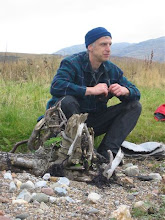


Today I was counting birds. I was carrying out a 2 hour bird count for a specific 2km square as part of the BTO Atlas, an attempt to map the distribution of the UK birds. The first hour was along the woodland edge of Flanders, the second hour was to be back across the open moss. But the birds were thin on the ground. Carrion crows, rooks and jackdaws stalked the farmland but in the woods it was silent. These edge woods, a bog habitat called the rand, are an under rated place. They are not of the conservation value or the majesty of the open bog vistas but are achingly beautiful in their own right, the subtle pattern of tall straight birches broken by the occasional twisted and gnarled tree made beautiful by disease. In the gaps the floor is littered with gonks of battered Molinia grass and scatter cushions of Polytrichum moss. But so few birds. Only a party of great and coal tits, goldcrests and treecreepers passing through make it onto the notepad. It has been a hard winter and some will have perished but it maybe just that others have moved to places with more food like gardens. Not a robin or a wren were heard so spring will tell if they have survived and returned. In the past these woods have been the dumping ground for the local farms and the evidence of this abuse it still there, amongst the metal work a fine bog, on a bog. The only sign of more recent abuse a single birch felled and removed, most probably for Christmas logs.
At half-time it was time to head out onto the open bog and face up to the nagging north wind. Out there a couple of crows hang around. Are there bog crows and farmland crows and do the bog crows chose to be there ? Or do they just move around all habitats looking for feeding opportunities as they go ? But the bog was as quiet as the woods, not a peep of a meadow pipit, not a chack of a stonechat nor pheep of a reed bunting, just the rumble and hiss of the wind. But Flanders always delivers and suddenly charging low over the moss with the wind went a peregrine looking as tight and muscular as a greyhound. And 5 minutes later a red kite sauntered north scoping the ground as it went. I finished up at the High Moss Pow where a line of old, twisted hawthorn mark an ancient land boundary. A final list of only 17 species of birds a poor haul even for winter on Flanders.






